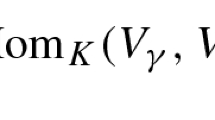Abstract
We prove the Cramér theorem forK-invariant Gaussian measures on irreducible symmetric spacesX=G/K withG semisimple noncompact. To do this we use a kind of Abel transform ofK-invariant measures onX.
Similar content being viewed by others
References
Faraut, J. (1983). Analyse harmonique sur les paires de Guelfand et les espaces hyperboliques,Analyse Harmonique, les Cours du C.I.M.P.A., Nice, pp. 315–446.
Feller, W. (1966).An Introduction to Probability Theory, Volume II, Wiley, New York.
Graczyk, P. (1992). A central limit theorem on the space of positive definite symmetric matrices,Ann. Inst. Fourier, Vol. 42 (to appear).
Graczyk, P. Dispersions and a central limit theorem on symmetric spaces,Bull. Sc. Math. (to appear).
Heyer, H. (1977).Probability Measures on Locally, Compact Groups, Springer Verlag, Berlin.
Helgason, S. (1970). A duality for symmetric spaces with applications to group representations,Advances in Mathematics,5, 1–154.
Helgason, S. (1984).Groups and Geometric Analysis, Academic Press, New York.
Letac, G. (1981). Problèmes classiques de probabilité sur un couple de Gelfand, Analytical methods in probability theory,Proceedings, Oberwolfach 1980, LNM 861, 93–120.
Author information
Authors and Affiliations
Additional information
This research is supported by KBN Grant.
Rights and permissions
About this article
Cite this article
Graczyk, P. Cramér theorem on symmetric spaces of noncompact type. J Theor Probab 7, 609–613 (1994). https://doi.org/10.1007/BF02213571
Received:
Issue Date:
DOI: https://doi.org/10.1007/BF02213571



